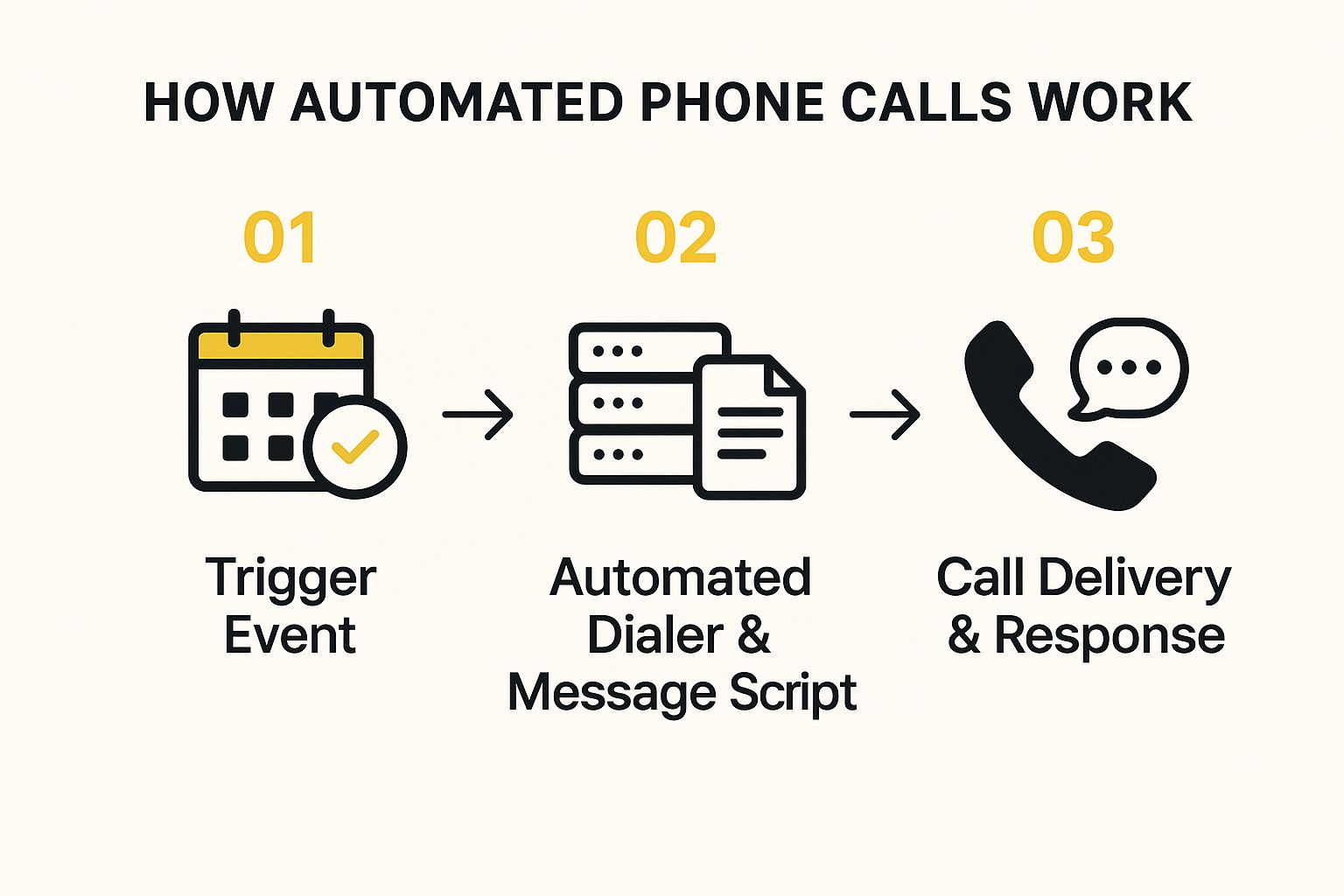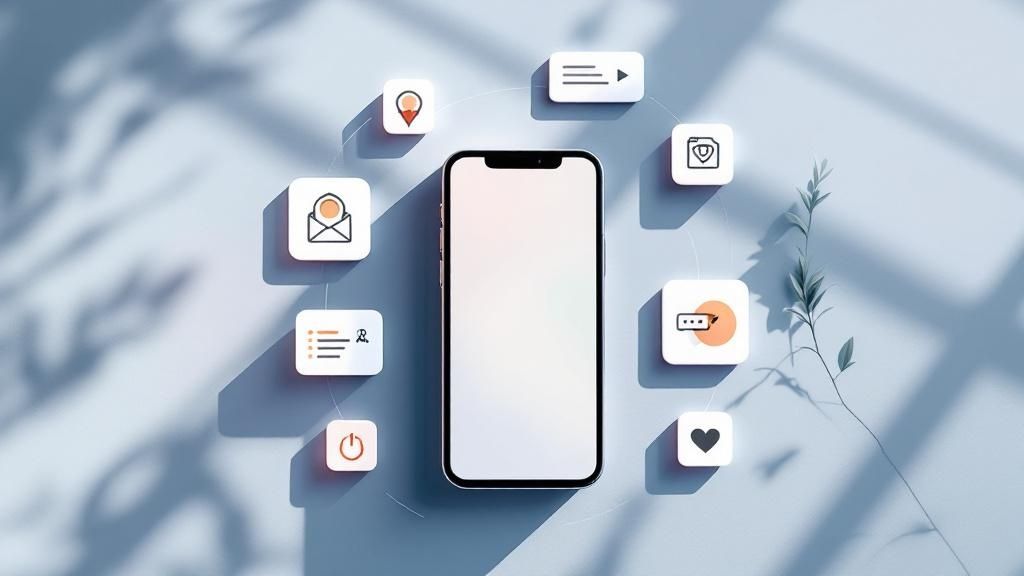Let's be honest, when you hear "automated phone calls," your mind probably goes straight to those annoying, pre-recorded robocalls that always seem to ring at dinnertime. While that's certainly one side of the coin, modern automated calling has evolved into a genuinely useful tool for businesses—when it's used the right way, of course.
Why Automated Phone Calls Are a Modern Business Tool

It’s time to reframe the conversation. Think of automated calls less like a sledgehammer and more like a smart, programmable assistant. This is technology designed to handle the repetitive, everyday communication tasks, freeing up your team to focus on the complex, human conversations that really matter.
This guide will take you beyond the spammy stereotype. We’ll show you how ethical, well-planned automated calling can actually boost customer engagement, make your operations run smoother, and help your business grow.
Navigating Public Perception in Australia
The biggest hurdle for any business thinking about this technology is the public's perception. The sheer volume of scam calls has created a huge trust barrier, and legitimate businesses have to be smart about how they navigate it.
And the problem is massive. Back in 2020, a staggering 42% of all scam reports in Australia were phone-related. The year before that, Aussies lost over $32.6 million to dodgy calls. This data from the Australian Communications and Media Authority (ACMA) paints a clear picture of why people are so sceptical of an unknown number or automated voice. You can get the full rundown on the impact of scam calls over on the ACMA website.
The secret for modern businesses is to be different. When you use automated calls for clear, consensual, and genuinely helpful reasons, you instantly separate your brand from all that noise and start building trust instead of burning it.
The Legitimate Business Case
Despite the bad rap, the operational benefits are impossible to ignore when you do it right. Automated phone calls aren't just for blasting out announcements; they’re for creating smart, efficient ways to communicate.
Here are just a few ways clever businesses are using them:
- Appointment Reminders: Medical clinics and service businesses use automated calls to slash their no-show rates. It's a simple fix that directly protects their bottom line.
- Critical Alerts: Think schools, emergency services, or utility companies. They can get urgent information out to thousands of people in minutes, keeping everyone safe and in the loop.
- Customer Feedback: After a customer interaction, a quick automated call can gather feedback using simple keypad responses. This gives you instant data to see what’s working and what’s not.
- Order and Delivery Updates: E-commerce businesses keep customers happy and informed about their purchase status, which makes for a much better experience all around.
By zeroing in on these value-packed applications, businesses can turn this technology into a powerful asset. It's all about delivering helpful, timely information that customers actually appreciate.
How an Automated Call Actually Reaches Your Customer
So, what's really going on behind the scenes when an automated call hits your customer's phone? To get the most out of these systems, it helps to peek under the bonnet.
Think of it like having a super-efficient assistant who can dial thousands of numbers at once, nail the message perfectly every single time, and even listen for a response. That’s the core idea, turning a simple phone call into a seriously powerful communication tool.
At its heart, the whole thing is a slick, tech-driven process. It doesn't start with a dial tone, but with a digital trigger—some kind of event that kicks the whole communication chain into gear.
This visual shows how something as simple as a scheduled appointment can trigger the whole automated sequence, from dialling the number right through to the customer's interaction.

The infographic breaks down the journey from a bit of data to a meaningful conversation, showing just how efficient the system can be.
The Software and the Script
It all kicks off inside a software platform. This is your command centre, where you upload your contact lists and write the message you want to get across. And we're not just talking about recording your own voice anymore.
Modern platforms use clever Text-to-Speech (TTS) technology that turns written text into a voice that sounds surprisingly human. This means you can easily personalise messages with things like customer names, appointment times, or other specific details without having to record thousands of different versions.
For instance, a script could say, "G'day, [Customer Name], just a friendly reminder about your appointment on [Date] at [Time]." The system then grabs the right details from your contact list for each call, making every message feel personal and relevant.
Plugging into the Phone Network
Okay, so your list is loaded and your script is good to go. Now the system needs a way to actually place the calls. That's where the telephony infrastructure steps in. Most current systems use Voice over Internet Protocol (VoIP), which shoots the call data over the internet instead of relying on old-school phone lines.
Think of VoIP as the bridge that connects your digital message to the global phone network. It's this tech that makes it possible to place thousands of calls at the same time, affordably—something that would be a nightmare with standard phone lines. It’s the engine that gives automated calling its scale.
A huge plus of this digital setup is its flexibility. Unlike old-school robocalling machines, modern software can smartly manage how fast it calls, retry busy numbers, and keep a careful record of what happened with every single dial.
Making the Call a Two-Way Street
The last piece of the puzzle—and maybe the most important—is what turns the call from a one-way announcement into a proper two-way conversation. This is handled by Interactive Voice Response (IVR), the tech that lets customers respond using their keypad or even their voice.
When a customer gets that automated appointment reminder, the IVR is what lets them press '1' to confirm, '2' to reschedule, or '3' to cancel. That response is logged instantly back in the system, giving you real-time feedback without a single human needing to lift a finger.
The potential uses for this are massive and can get surprisingly sophisticated.
- Simple Confirmations: Perfect for appointments, deliveries, or reservations.
- Customer Surveys: You can gather feedback by asking customers to rate their experience on a scale of 1-5.
- Getting Information: Callers can check things like account balances or order statuses just by punching in an account number.
This interactive capability takes automated calling from a basic broadcast tool to a genuine customer service and engagement solution. To really get into the nitty-gritty, you can learn more about what Interactive Voice Response is and see how it’s the backbone of today's automated communication. By letting customers take action, IVR makes the whole process more valuable for you and for them.
From Robocalls to AI Conversations: The Big Leap Forward

The journey of the automated call is a classic story of tech evolution. What started as clumsy, one-way "robocalls" has morphed into something far smarter and more interactive. It’s been quite the glow-up.
In the beginning, these systems were blunt instruments. Think of a megaphone blasting the same pre-recorded message to a massive list of numbers. There was zero room for interaction, which is exactly why automated phone calls got such a bad rap—they were impersonal, annoying, and usually hit you at the worst possible time.
The first real step up was Interactive Voice Response (IVR). This turned the monologue into a basic dialogue, letting you press keys on your phone to get things done. Suddenly, a call could be more than just a blast announcement; it was a way to confirm an appointment or navigate a simple menu. A small step, but a crucial one.
Enter Conversational AI
Fast forward to today, and we're in a completely different ballpark, thanks to Artificial Intelligence (AI) and Natural Language Processing (NLP). The jump from IVR to modern AI is like going from a pocket calculator to a supercomputer.
Today's systems don't care about keypad inputs. Instead, they can understand what you're saying, figure out your intent, and hold a conversation that feels surprisingly natural. This is all powered by complex algorithms that can pick up on the nuances of speech, tone, and context.
To really get your head around this, it helps to understand how Voice to Text AI works, because that’s the engine under the hood. It translates spoken words into text the AI can analyse and respond to in a split second.
This opens the door to some seriously clever applications:
- Natural Language Appointment Booking: A customer can just say, "I need to book a trim for next Tuesday arvo," and the system gets it. No menus, no fuss.
- Intelligent Call Routing: Instead of listening to a long list of options, a caller can just explain their problem, and the AI sends them to the right person.
- 24/7 Customer Support: AI agents can answer common questions, check on an order, or process a payment anytime, day or night, without a human needing to lift a finger.
The Double-Edged Sword of AI
But let's be real—this evolution has a dark side. The same powerful AI that helps a virtual assistant book your appointments is also being used by scammers to create scarily convincing deepfake voices and clever fraud schemes.
This has, quite rightly, made people suspicious. The rise of malicious AI-powered calls has put a lot of Aussies on edge, as deepfakes and AI-generated voices become harder to spot. It’s a major reason why people are so wary of their phones ringing.
A recent report found this growing scepticism is changing habits, with 48% of consumers saying they now never answer calls from unidentified numbers. This is largely driven by a fear of AI-powered scams, which are becoming almost impossible to distinguish from legitimate calls. You can dive deeper into the findings in the Hiya State of the Call 2025 report.
This tech arms race puts legitimate businesses in a tricky spot. On one hand, you have incredible AI tools to make everything more efficient. On the other, the bad actors are wrecking the trust you need for those tools to even work.
For any business looking to use automated phone calls, knowing this is critical. The only way forward is to be completely transparent and provide genuine value, making your calls stand out from all the noise. By sticking to ethical practices and focusing on being genuinely helpful, you can build the trust you need to make this powerful technology work for you.
Strategic Business Applications for Automated Calling

Alright, let's move past the tech specs. The real magic of automated phone calls happens when you see them in action. Smart businesses aren't just using these tools to save a bit of time; they're solving genuine problems, getting customers more engaged, and giving their bottom line a healthy boost.
When you put a clear goal behind it, an automated call stops being just a robotic message. It transforms into a powerful way to connect. The trick is to stop thinking about it as just broadcasting information and start thinking about how you can create real value for the person on the other end of the line.
Let’s dig into how different industries are putting this to work.
Boosting Efficiency in Service Industries
If you're in a service-based business—think healthcare clinics, legal firms, or consultancies—you know that missed appointments are a killer for revenue. It’s a constant headache, but automated calls offer a surprisingly simple and effective fix.
Picture a busy medical centre. In the old days, a receptionist would have to block out hours every single day to manually ring patients and confirm their appointments. Now, an automated system can handle the whole lot, using a pre-recorded message or a natural-sounding voice to reach hundreds of people in the time it takes to make a coffee.
A great appointment reminder call is short and sweet. It confirms the date and time, then uses an interactive menu to ask the patient to press '1' to confirm or '2' to chat with reception and reschedule. This one little interaction is brilliant for cutting down no-show rates, protecting clinic revenue, and keeping the daily schedule running like clockwork.
This isn't about replacing people; it's about freeing them up. Your staff can now focus on the more complex, human-to-human tasks that really matter, while the system takes care of the repetitive grunt work.
Driving Engagement in Retail and E-commerce
In the cut-throat world of retail, getting your message seen is everything. An automated phone call can be your secret weapon, cutting through the noise of a packed email inbox for those really important announcements.
Imagine you’re launching a 24-hour flash sale just for your loyalty club members. An automated call delivers that news instantly, creating a sense of urgency that an email just can't match. It’s also a fantastic way to reach customers who aren't glued to their emails or social media feeds.
But it’s not just about sales. These calls are perfect for:
- Order and Delivery Updates: Automatically letting a customer know their package is on its way. This simple heads-up stops a flood of "Where is my order?" calls to your support team.
- Stock Alerts: Giving someone a buzz the moment that out-of-stock item they wanted is back. It’s a personal touch that customers love.
- Quick Feedback: A day after delivery, a simple automated call can ask for a quick star rating. You gather valuable feedback without any hassle.
Scaling Outreach for Campaigns and Logistics
When you need to contact thousands of people at once, automated calling is a non-negotiable tool. Political campaigns, for example, lean on this heavily for everything from polling and event invites to those all-important get-out-the-vote reminders.
Logistics and utility companies are in the same boat. They use automated calls for critical service updates that just can't wait. A delivery company can instantly inform everyone in a specific postcode about a delay, managing expectations and preventing a wave of frustrated calls. Likewise, a utility provider can send out urgent outage alerts to keep the public safe and informed.
To give you a clearer picture, here’s a quick breakdown of how different sectors are using automated calls to their advantage.
Automated Call Applications Across Industries
The table below summarises a few practical ways automated calls are making a difference across various business sectors.
| Industry | Primary Use Case | Key Business Objective |
|---|---|---|
| Healthcare | Appointment reminders & confirmations | Reduce no-show rates and optimise staff time. |
| Retail & E-commerce | Flash sale alerts & order updates | Drive immediate sales and improve customer experience. |
| Finance & Banking | Fraud alerts & payment reminders | Enhance security and reduce late payments. |
| Logistics & Transport | Delivery notifications & service delays | Increase operational transparency and manage expectations. |
| Utilities | Outage alerts & maintenance warnings | Ensure public safety and provide critical information. |
| Political Campaigns | Voter reminders & event invitations | Maximise voter turnout and event attendance. |
As you can see, the applications are incredibly versatile, each tailored to solve a specific business challenge.
The principle behind all these examples is identical: using automation to deliver the right information, to the right people, at the right time—and at scale. If you're looking at bringing this kind of efficiency into your own operations, checking out an automated phone answering system is a fantastic place to start. By automating both your incoming and outgoing calls, you build a much smoother experience for your customers and a smarter workflow for your team.
Navigating Australian Compliance and Best Practices
Using automated phone calls the right way means walking a fine line between being effective and being a nuisance. To stay on the right side of that line, you need to operate both ethically and legally. This is your guide to playing by the rules in Australia, ensuring you build customer trust rather than burning it down.
Let's be clear: getting this right is what separates a valued message from annoying spam.
The main player here is the Australian Communications and Media Authority (ACMA). Their job is to protect consumers from unwanted contact, and their rules are designed to ensure you're transparent. Ignoring them can lead to some seriously hefty penalties, so understanding the basics is non-negotiable.
Understanding the Core Rules
At the heart of Australian compliance is a simple idea: consent. You can't just blast out a marketing message to anyone you feel like. The rules are crystal clear, especially when you're trying to sell something.
It all boils down to three key pillars:
- The Do Not Call Register: Think of this as a national "no junk mail" list for phone numbers. It's a database where people can opt out of unsolicited telemarketing calls. Before you even think about launching a campaign, you absolutely must scrub your list against this register and remove any matches.
- Permitted Calling Hours: You can't just ring people at all hours of the day. ACMA has set specific windows to respect people's downtime. Generally, you can call from 9:00 am to 8:00 pm on weekdays and 9:00 am to 5:00 pm on Saturdays. Sundays and national public holidays are a complete no-go.
- Informed Consent: This is a big one. For any marketing call, you need the person's express or inferred consent to contact them. Just having their number doesn't count. They need to have given you permission, either directly or through their actions (like filling out a form).
The golden rule is simple: if your call is designed to sell something, you need permission. For purely informational messages, like an appointment reminder or a fraud alert, the consent rules are a bit different, but the principles of respect and transparency still apply.
Best Practices Beyond the Law
Just following the law is the bare minimum. If you want to build a good reputation, you need to go further. The best campaigns are the ones that people actually find helpful.
Mastering these principles is how you run campaigns that customers appreciate and regulators have no problem with.
Always Provide Clear Value
Every single automated call should instantly answer the customer's unspoken question: "What's in it for me?"
Whether it's a critical appointment reminder, a fraud alert from their bank, or an update on a delivery, the message has to be immediately useful. A call that helps someone avoid a missed appointment fee is valuable. A vague marketing pitch is just noise.
Keep It Brief and Respectful
Time is everyone's most valuable asset, so don't waste it. Get straight to the point. State who you are and why you're calling within the first few seconds. A short, sharp message shows you respect the other person's time and makes them way more likely to actually listen.
Personalise When Possible
Technology makes it easy to add a personal touch. Using a customer's name or referencing a specific order makes the whole thing feel more human and relevant. It’s a simple move that transforms a generic broadcast into what feels like a one-to-one chat, and that can dramatically improve how people respond.
A great starting point for figuring out how to manage your call communications effectively is by exploring the features of a well-designed AI phone call assistant.
Offer a Simple Opt-Out
Finally, always give people a clear and easy way out. A simple "press 9 to unsubscribe" is standard practice for a reason. Making it hard to opt out is not only frustrating for the customer but it's a huge red flag for regulators. By giving people control, you show respect and keep your contact list full of people who actually want to hear from you.
Picking the Right Automated Calling Platform
Choosing the right platform for your automated calls is a make-or-break decision for your campaigns. The market is absolutely flooded with options, so knowing what to look for from the get-go will save you a world of headaches and make sure you’re getting a solid return on your investment. It’s not about finding the one "best" platform, but the one that’s the perfect fit for your specific business needs.
A great way to get your bearings is to check out a comprehensive business phone system comparison guide. This kind of initial research helps you map out the landscape before you get bogged down in the nitty-gritty of what each provider offers.
Your first port of call should be the user interface. You need something intuitive and easy to get around in. Can you set up and launch a campaign without calling in the IT department? If it’s too complex, you’ll just slow yourself down and risk making costly mistakes.
Core Features to Look For
Beyond a pretty interface, the platform needs some real power under the bonnet to get you the results you’re after. Scalability is a big one. You need a system that can handle your current call volume, sure, but it also has to be able to grow with you—whether that means sending a hundred calls today or a hundred thousand next year.
Next, have a good, hard look at its Interactive Voice Response (IVR) capabilities. A basic IVR is pretty standard these days, but a truly powerful one lets you build multi-level menus and route calls intelligently based on what your customers do. This is the difference between making a helpful, two-way conversation and just blasting out one-way announcements. It's a technology that’s even being embraced by government bodies right here in Australia.
For instance, Services Australia uses AI in its IVR services to get calls to the right place, faster. Their system spots patterns in calls to help deliver services more effectively, showing just how much intelligent automation is being woven into the fabric of national services. You can read more about their automation and AI strategy.
Analytics and Integration Are Non-Negotiable
You can't fix what you don't measure. A solid analytics dashboard isn't a "nice-to-have"; it's essential. Make sure the platform you're considering offers detailed reports on the metrics that actually matter:
- Call Completion Rates: Out of all the calls you sent, how many actually connected?
- Response Tracking: Which options did people press in your IVR menu?
- Drop-off Points: At what point in the call are people giving up and hanging up?
Finally, think about integration. The platform absolutely must talk to your existing Customer Relationship Management (CRM) software. This is crucial. A good integration means you can automatically log call results, update customer files, and even kick off follow-up actions, creating a slick, connected workflow. Without it, you're stuck manually copying and pasting data, which completely defeats the whole point of automation in the first place.
When you're weighing up different platforms, it helps to see what features come standard at different price points.
Comparison of Automated Calling Platform Features
| Feature | Basic Platform | Advanced Platform | Enterprise Platform |
|---|---|---|---|
| Pre-recorded Messages | ✅ | ✅ | ✅ |
| Basic IVR Menu | ✅ | ✅ | ✅ |
| Scalability (Calls/Hour) | Up to 1,000 | Up to 10,000 | 100,000+ |
| Real-time Analytics | Limited | ✅ | ✅ |
| CRM Integration | Basic (e.g., Zapier) | Native Integrations | Custom API Access |
| Multi-level IVR | ❌ | ✅ | ✅ |
| Text-to-Speech | ❌ | ✅ | ✅ (with custom voices) |
| Dedicated Support | Email only | Phone & Chat | Dedicated Account Manager |
This table gives you a snapshot of how features typically stack up. As you can see, the more you invest, the more powerful the tools for customisation, integration, and large-scale deployment become. Choose the tier that not only fits your current needs but also gives you room to grow.
Got Questions About Automated Phone Calls?
Dipping your toes into the world of automated communication can bring up a few questions. To help you make clear, informed decisions, we've pulled together some straightforward answers to the queries we hear most often from business owners about using automated phone calls.
This section tackles the key legal, financial, and technical stuff you're probably wondering about.
Are Automated Marketing Calls Legal in Australia?
Yes, but you’ve got to play by the rules. Here in Australia, the Australian Communications and Media Authority (ACMA) is the referee. For any kind of telemarketing call, you absolutely must have the person's consent to contact them, and you’re required to check your list against the Do Not Call Register.
On top of that, all your automated calls need to:
- Show accurate caller ID info so people know it’s you calling.
- Stick to permitted hours (that’s generally 9 am-8 pm on weekdays and 9 am-5 pm on Saturdays).
- Give the person a simple, clear way to opt out of any future calls.
Sticking to these rules isn't just about staying compliant; it's about running an ethical campaign that people will actually respect.
How Much Does an Automated Calling Service Cost?
The price tag on an automated calling service really depends on the provider you choose and how much you plan to use it. You'll generally come across a few common pricing models, each designed for different kinds of business needs.
- Pay-Per-Call/Per-Minute: This is your classic pay-as-you-go option. It’s perfect if you only need to make calls every now and then or if your call volume is unpredictable.
- Tiered Subscription Plans: Most platforms will offer monthly or yearly plans. These give you a set number of calls or minutes for a fixed price and often throw in more advanced features as you move up the tiers.
- Custom Enterprise Pricing: If you're planning on making a massive number of calls, providers will usually work with you to create a custom package that includes things like dedicated support and specialised integrations.
Can Automated Calls Actually Sound Human?
They definitely can, but it all comes down to the tech behind them. Those robotic, monotone voices from old-school systems are quickly becoming a thing of the past. Modern platforms are now using advanced AI to create voices that are incredibly natural and conversational.
Here’s a pro tip: when you’re checking out a platform, always listen to their voice samples. Look for a service that offers high-quality, AI-generated voices with realistic pacing and intonation. It makes a massive difference in how your message lands and can seriously boost customer engagement.
The goal isn't to fool someone into thinking they're talking to a real person. It's about delivering a message that's clear, professional, and pleasant to listen to—something that reflects well on your brand.
Stop wasting time on repetitive calls and endless voicemails. OnSilent filters your calls, transcribes your messages, and organises your communications so you can focus on what really matters. See how much time you can save at https://onsilent.com.

